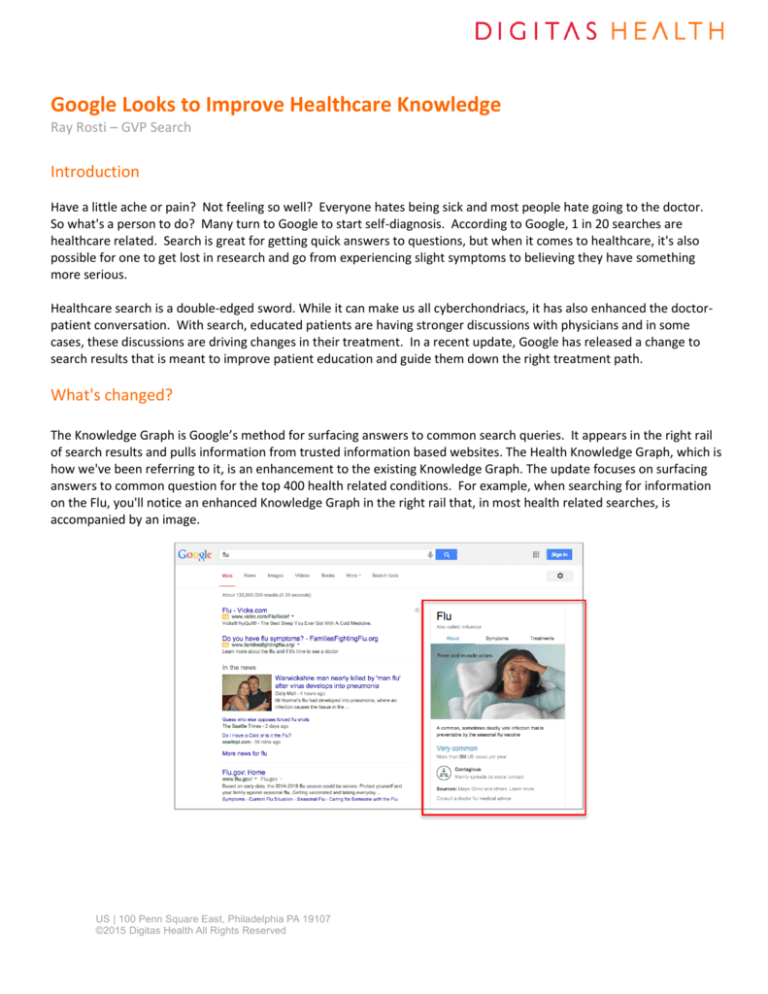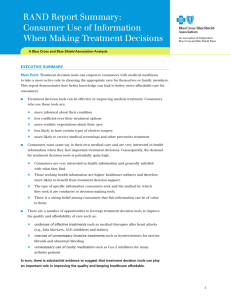
Google Looks to Improve Healthcare Knowledge
Ray Rosti – GVP Search
Introduction
Have a little ache or pain? Not feeling so well? Everyone hates being sick and most people hate going to the doctor.
So what's a person to do? Many turn to Google to start self-diagnosis. According to Google, 1 in 20 searches are
healthcare related. Search is great for getting quick answers to questions, but when it comes to healthcare, it's also
possible for one to get lost in research and go from experiencing slight symptoms to believing they have something
more serious.
Healthcare search is a double-edged sword. While it can make us all cyberchondriacs, it has also enhanced the doctorpatient conversation. With search, educated patients are having stronger discussions with physicians and in some
cases, these discussions are driving changes in their treatment. In a recent update, Google has released a change to
search results that is meant to improve patient education and guide them down the right treatment path.
What's changed?
The Knowledge Graph is Google’s method for surfacing answers to common search queries. It appears in the right rail
of search results and pulls information from trusted information based websites. The Health Knowledge Graph, which is
how we've been referring to it, is an enhancement to the existing Knowledge Graph. The update focuses on surfacing
answers to common question for the top 400 health related conditions. For example, when searching for information
on the Flu, you'll notice an enhanced Knowledge Graph in the right rail that, in most health related searches, is
accompanied by an image.
US | 100 Penn Square East, Philadelphia PA 19107
©2015 Digitas Health All Rights Reserved
Searchers can also access the Health Knowledge Graph on mobile search. Because there is no right rail on mobile
search results, the new format occupies the top of the search results page and pushes all other results far below the
fold. Additionally, Google focused heavily on voice search for this update. This gives users the ability to ask a question
such as "what is the flu?” which triggers the Health Knowledge Graph. The Knowledge Graph breaks the content
surrounding the search into 3 categories represented by the tabs at the top of the Graph box.
Tab 1- About
Tab 2- Symptoms
Tab 3- Treatment
The first tab titled “About”,
focuses on basic information
about the condition. In the
example above, the
information is focused on the
flu. It informs the searcher
about basic questions such as
how it's spread, the type of
treatment required and the
duration of the condition.
The second tab titled
“Symptoms” focuses on
common symptoms to help
the user correctly identify the
types of symptoms they may
be experiencing as well as
symptom location.
The final tab titled
“Treatments” focuses on
educating the searcher on
both self-treatments and
prescription treatments.
Additionally, the treatment
tab educates searchers on
whether or not they should
consult a physician.
While this guides users through the common path from condition to symptoms to treatment, we've observed that in
many cases, when searching for condition [e.g. type II diabetes] or condition symptom information, the Knowledge
Graph is served, but when searching specifically for condition [e.g. type II diabetes] treatment information, Google
refrains from serving the Knowledge Graph. This would indicate that Google is strongly focusing on educating those
US | 100 Penn Square East, Philadelphia PA 19107
©2015 Digitas Health All Rights Reserved
searchers who are in the earlier stages of their research, whereas searchers who are further down the funnel are most
likely looking for more robust, on-page content.
The information provided within the Health Knowledge Graph is sourced from endemic health sites such as the Mayo
Clinic and WebMD, as well as government sites such as the NIH and CDC. While this information comes from reliable
sites, Google also provides users the ability to report errors in the information provided.
What impact will this change have on the health search landscape?
The update is only a week old, so it's hard to predict whether or not users will find it useful. It's even harder to predict
whether or not it will have a major impact on healthcare search, or if it will only be a blip on the radar. The one thing
that is clear is that Google continues to evolve the Knowledge Graph, so it's pretty safe to say that it isn't going away
anytime soon. As we analyze the latest evolution of the Knowledge Graph, we've put together a few impacts we feel
the latest change will have on the healthcare search landscape.
Endemic Health sites will feel the biggest impact
With Google focused on providing quick answers to searchers higher in the funnel, endemic health sites, like
WebMD, who typically dominate the top search results, may feel the biggest impact. With answers being
surfaced within the Knowledge Graph, users will not have to click-through to websites to get the answers they
need. This could have a serious impact on traffic to these sites and the impressions they need to serve ads. The
other potential impact to these sites is the perception of biased vs. unbiased content. Google is presenting
Knowledge Graph content as being unbiased and vetted through a panel of experts. Google is also toeing the line
between search engine and content provider. This could project the impression that information found on
endemic health sites is potentially biased.
Paid Search could become more competitive for top of the funnel searches
The Knowledge Graph dominates the right rail of search results, thus pushing right rail Paid Search ads far below
the fold towards the bottom of the page. This makes the top 3 listings in the middle of the page much more
valuable and potentially more competitive. Search marketers in competitive categories should anticipate
increases in CPCs for these top 3 positions in the coming months. If endemic health sites feel the crunch of
decreased impressions, don't be surprised if they turn to Paid Search to drive visits to meet impression goals.
Mobile search visibility will become more difficult
Mobile search for health is an important place for visibility in healthcare. Mobile devices are usually private,
allowing searchers to look for sensitive health-related information. This is compared to more traditional desktop
or laptop computers that are often shared or owned by their place of employment. 2014 was also the year we
saw mobile searches in health reach impression levels equal-to or greater-than desktop searches. Because of
these shifts, mobile has become an important point of contact with patients. The Knowledge Graph's placement
in mobile dominates the results page, and pushes organic listings far down on the page. With limited organic
US | 100 Penn Square East, Philadelphia PA 19107
©2015 Digitas Health All Rights Reserved
visibility, Paid Search may need to supplement these searches in order to reach searchers as they enter the
category.
Treatment search visibility becomes more important
If you believe the Knowledge Graph will be successful in educating patients, then the patient’s next search after
engaging the Knowledge Panel becomes an important moment to connect. The intent of the Knowledge Graph is
to educate patients, by guiding them from condition information through to treatment options. While Google
mentions treatment options, it does not recommend what treatment is the best fit for a patient. The next logical
step for patients is to research the various treatments available. If successful, the Knowledge Graph should move
searchers into treatment research mode quicker and deliver a more informed searcher into solution-based
queries.
Knowledge Graph accuracy will need to be monitored
Information is being populated from trusted sources, however there’s no guarantee that all of the provided
information will be completely accurate. Marketers should monitor what information is being provided to
patients. While it's unclear how much influence the feedback mechanism will have on what is displayed, it's still
important to provide feedback. It's also unclear how often Google will update this information, so consistent,
relevant feedback may be the best approach to improving information provided.
Lifestyle education may lead to stronger interest in education
One interesting part of the treatment education is the presentation of lifestyle education as part of the treatment
regimen. While it's no secret that a healthy lifestyle leads to a healthier life, pairing specific lifestyle solutions
with specific conditions could lead to further searches within a condition for specific lifestyle content. Monitoring
search impressions around lifestyle searches should prove whether or not this information has an impact on
patient interest. It's recommended that marketers pay attention to the search interest around lifestyle content
and be prepared to create content to meet increased demand.
Final Thoughts
The intent of this change is to improve patient education and get them to a solution quicker. As stated earlier, search’s
greatest contribution to healthcare is patient education and the improved conversations between patients and
physicians. While this change potentially presents challenges for search marketers, it's safe to say that Google will
never make a change to search that would jeopardize the revenue generated through Paid Search listings. If this
change furthers patient education, then this update will ultimately prove to be a welcome addition to healthcare
search.
US | 100 Penn Square East, Philadelphia PA 19107
©2015 Digitas Health All Rights Reserved





